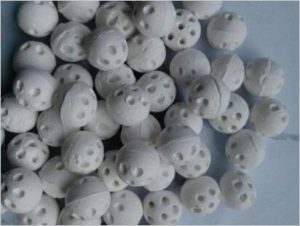Gasoline hydrogenation catalyst support media


are mainly applied for removing iron, nickel, vanadium, calcium and sodium oil products. Besides, they also show an effect in eliminating sulfur from non-hydrocarbon materials.
In oils, there are many amounts of Ni, V, Fe and other metals left there. These materials exist in glues and asphalts via the format of organic compounds. Through hydrogenation reaction, they are finally precipitated by the format of metal sulfides left on the surface of catalyst or channel entrance. These metal sulfides reduce the activity of catalyst, increase resistance and pressure drop as well as shorten reaction cycle. With the assistance of catalyst bed support media, these negative effects will effectively slowed down.
Main Features of Gasoline Hydrogenation Catalyst Support Media
- High Porosity
The special shape and structure of inert balls assure a high porosity and sufficient space for storing impurities.
- Medium Activity
If the activity is too high, excess impurities will react and produce solids (like metal sulfides and coke), which will deposit in a certain part of the bed and cause increased pressure drop. Therefore, the gasoline hydrogenation catalyst support media is specially developed with a medium activity.
Specifications of Gasoline Hydrogenation Catalyst Support Media
| Model | Active metal | Appearance | Pore diameter, Φ mm | Length, mm | Pore volume, ml/g | Specific surface area, m2/g |
| LSC-21 | Seven-pore ball | 15-18 | – | 0.15-0.3 | 1~30 | |
| LSC-22 | Molybdenum, nickel | Raschig ring | 4.9-5.2 | 3~10 | 0.6-0.8 | 260-330 |
carrier@catalystcarrier.net
